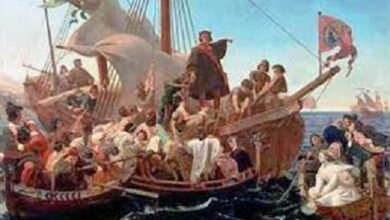Causes of the Glorious Revolution Development consequences Importance
Glorious Revolution
Revolutionary process that, between 1688 and 1689, put an end to the absolutist monarchy and enshrined the advent of the parliamentary monarchy in England. In this article we will provide you the Causes and consequences of Glorious Revolution.
The Glorious Revolution was a revolutionary process that occurred in England between 1688 and 1689 , which overthrew King James II Stuart and brought his daughter Mary II and her husband, William III of Orange, to power.
The Revolution was fostered by the English Parliament , which viewed with great concern the king‘s absolutist attempts and his attempts to re-implant Catholicism in a predominantly Protestant society .
For some authors it was more a coup d’état than an authentic revolution, since it originated in a conspiracy of the nobles of Parliament , with very little participation from the majority of the people.
The Glorious Revolution put an end to the political instability that from 1642 characterized the English Revolution . It marked the end of the absolutist monarchy and the consecration of the parliamentary monarchy .
Enhance your reading: Stages of French Revolution with causes detail
Development of the Glorious Revolution
The Glorious Revolution comprises the following stages.
Conspiracy
Before his coronation, in 1685, the Protestant nobles of Parliament viewed Jacobo Estuardo, who was a Catholic, with suspicion. The situation of tension became untenable when the king‘s heir was born on June 10, 1688. The prospect of the start of a Catholic dynasty in the British Isles brought together most of the members of Parliament, who began to conspire against the king. A group of nobles got in touch with Guillermo de Orange , statutory of the United Provinces and son-in-law of the king, due to his marriage to his daughter Maria. Both were Protestants and grandsons of the executed Charles I. The nobles offered him the crown of England, on the condition that he make limited use of royal power.
Preparations and landing in England
Guillermo chartered a fleet of 400 transport ships and hired some 15,000 Dutch mercenaries. In October 1688 he embarked for England, escorted by the war fleet of the United Provinces and with the support of the States General. He landed his army in Devon and advanced slowly towards London, hoping that his English allies would take the initiative. After William’s troops defeated the king‘s in a skirmish, James fled before Christmas and went into exile at the court of Louis XIV of France.
Coronation
In February 1689 the Parliament declared that the flight of Jacobo meant an abdication and proceeded to the coronation of Guillermo and María as joint rulers . Shortly afterwards, Parliament passed the “Act of Tolerance” and the “Bill of Rights”. The Act guaranteed tolerance to all non- Anglican Protestants , but not to Catholics. The Declaration restricted the powers of the king, taking away the powers to suspend laws, create taxes, or maintain a standing army without the permission of Parliament. In this way, he protected subjects from possible abuses of royal power.
Jacobite wars
James’ followers in Ireland and Scotland, known as Jacobites, viewed the coronation of William and Mary as a coup and prepared to resist. Soon after, Jacobo, ready to regain the throne, landed in Ireland with 6,000 French soldiers. But he was defeated by William’s supporters in 1690 and returned to France. Some of his supporters continued to fight, but surrendered in 1691, following the signing of the Treaty of Limerick , which guaranteed their lives and the non-confiscation of their property.
Enhance your reading: Bourbons in the different regions in detail
Causes and consequences of the Glorious Revolution
Causes
The main causes of the Glorious Revolution were the following:
- The will of King James II Stuart to impose an absolutist style of government , based on the theory of the divine right of kings.
- The attempt of the king to re-implant Catholicism in England , which generated great discontent among the majority of his subjects, who were Protestant.
- The will of the majority of the members of Parliament to impose limits on royal power and to defend the Anglican Church .
- The ambitions for power of the king’s daughter, Maria, and her husband William of Orange, added to their desire to defend Protestantism.
Consequences
The main consequences of the Glorious Revolution were the following:
- The bloodless abdication of Jacobo II and the assumption in his place of his daughter María II and Guillermo de Orange , son-in-law of the deposed king and until then stadholder of the United Provinces. The new monarchs had to commit to maintaining Protestantism and giving full legislative rights to Parliament.
- The final elimination of the absolutist monarchy in England, which was replaced by a parliamentary monarchy , in which Parliament shares power with the king.
- The proclamation of the “Bill of Rights” , a document that today is one of the pillars of British society.
- Tolerance of all non-Anglican Protestants.
- He began a period of freedom , balance of powers and promotion of commerce and industry , thus creating the conditions for the beginning of the Industrial Revolution .
Importance of the Glorious Revolution
Despite having occurred towards the end of the 17th century , the Glorious Revolution is related to a series of revolutions that shook the Atlantic world between the late 18th and early 19th centuries . Unlike other revolutions, it was fundamentally bloodless in character , causing very few casualties except in Ireland and Scotland.
The Glorious Revolution gave rise to parliamentary democracy as a political system, which is still in force in Great Britain. In this form of government, Parliament has full legislative powers and the king, little power.
The Glorious Revolution, by deposing the Stuarts, ended any possibility of Catholicism being reestablished in Britain and thus ensured the primacy of Protestantism.
It was also the last successful invasion of the British Isles to date.
